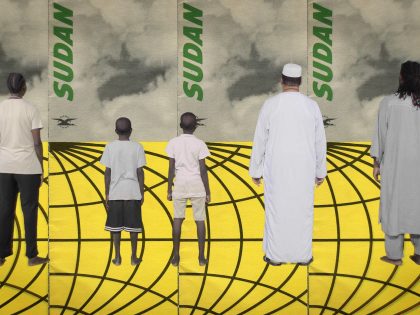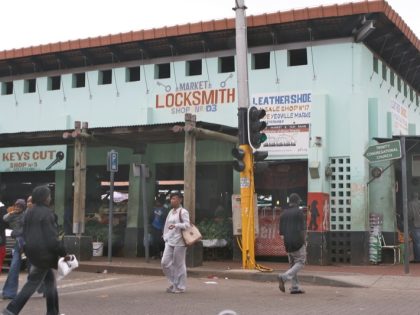Binyavanga’s writing out of depression
Writing on depression in Africa is a rarity, so Binyavanga Wainaina's book, "One Day I Will Write About This Place," seems singular.

Nakuru Lake, by Sergey Yeliseev. Via Flickr CC.
The wobbly giraffes doing the splits next to my bed reveal my recent bedtime narrative. Subconsciously and adrift, I appear to have amassed a week long collection of literary conquests, scampering around on my bookshelf. So, after placing them apologetically back on their communal bed — their shelf — I unpacked the delivery of Binyavanga Wainaina’s book, One Day I Will Write About This Place.
Opening in Kenya in the late 1970s, the birth of the story sees Wainaina at his most playful. A young boy of seven is recollected in acrobatic and staccato sentences. He exchanges tangential poetic imagery — imbued with color and lucidity — with structurally orientating map pins, which place you within the geography of the narrative. These pins serve as pricks for departure, and for the divergences and plasticity of his imagination and attention as “the shape” of his ideas start to “form. There is air, there is water, there is glass. Wind moving fast gives form to air; water moving fast gives it form. Maybe … maybe glass is water moving at super-speed, like on television, when a superhero moves so fast, faster than blurring, he comes back a thousand times before you see him move.”
These early sections feel like a memory, present but not wholly there, levitating above the pages, rather than just being self-evident of a ‘memoir’. His early self is absorbing — accreting himself and his landscape — by a multi-sensory osmosis. A landscape punctuated by Kenyatta, Afro’s, Diana Ross and the Jackson Five, careering out of TV’s, radio and posters.
If I focus, I can let it into me, let in the whole wide woosh of the world. I grit my teeth, harden my stomach […] If I get that moment right, I can let my mind burst out of me and fold into the world’. He exhibits a helpless fascination with sound; the sound of words, dividing the world into ‘sounds of onethings and the sound of manythings’; sketching people, history and emotions with the sounds they make; ‘frying sausages sound like rain on a tin roof, which sounds like a crowd.
Going even further to construct a “new word, my secret”, ‘Kimay’, a “talking jazz trumpet: sneering skewing sounds, squeaks and strains, heavy sweat, and giant puffed-up cheeks, hot and sweating; bursting to say something, and then not saying anything at all; the hemming and hawing clarinet. Kimay is yodelling Gikuyu women.” For Wainaina, ‘kimay’, is a way of seeing, of hearing.
Such a persistent use of sound livens his images, making them heard, orchestral. But, within the colorful compositions of sound there is a counter-melody, a disquiet, that radiates from his relationship with the exterior world of people and things and that which is interior. Recollections are assembled on tensions and imbalances. Where they interweave, a place forms for Wainaina, which he fears, “afraid of being hijacked by patterns”. Visual and emotional encounters introduced in the infancy of the book, like undercurrents, emerge in shifting and recomposed forms throughout, some painfully acute while others more quietly so.
Already by the age of 11, Wainaina is retreating to a refuge in fiction. His Ugandan mother interrupts his reading and stops him going to the library “because they found out that I had managed to spend the whole year avoiding math homework and reading novels in class”. A seeming place of safety to evade the impositions of his school and parents which, is for “future doctors, lawyers, engineers, and scientists” — a prescription that makes Wainaina uncomfortable and itchy, like wearing someone else’s clothes. During his time at boarding schools the sentences become less flighty, instead becoming increasingly affecting. Still ravenously reading but now turning the pages with a thumb “mushy and bleeding, with pus. Over the last few months, I have been peeling my nails with a razor blade during night prep. Short, right bursts of quiet peeling, nibbling and scraping, only stopping to turn the page of my novel.”
Writing on depression in Africa is a rarity. Here, Wainaina’s book seems singular. While at a South African university studying commerce, Wainaina’s equilibrium alters dramatically. His unevenness sees his tight rope walker plunge, as he “moves out of the campus dorms and into a one-room outhouse [falling] away from everything and everybody”. Within this room he barely leaves, the scope of the writer-camera adjusts to macro. The scenes thickly stick to objects surrounding him, bound in vignettes:
when you are lazy and locked in your room for days, fluff, in the right light, looks like thousands of starlike creatures somersaulting in the air. They swell out of nothing and somersault and burst or vanish again into nothingness, and others swell, as if something on the other side of reality is blowing the smallest bubbles in the through holes we can’t see.
Only reading remains; exchanging books and stealing a few from a second-hand bookstore. Wriggling “back into my own pillow […] tears start falling, and they don’t stop.” On the disparate occasions that the gravity of the room frees Wainaina to leave, it is only a bottle smashed over his head — the resolution of a fight — that pierces his stupor. He describes it lovingly as “wonderful. There are little delicious explosions in my head for days.” Such a long period of paralysis, a disfiguring depression, is contained in a seemingly short section. As if resurrecting this time is too painful, or the time was stolen away from him. But its re-emergence is discernible thereafter, returning in a less debilitating form, as Wainaina awaits ‘the next surge’.
By the midpoint of the book Wainaina still appears nomadic, having lived in different geographical and mental locations without explicitly announcing a mentionable love for one above, or besides another. Yet, weary of his mental health he returns to Kenya, “I want to be home,” he writes, “just to be home.” His continuing struggle and recovery is then perceived and expounded through his family and their concern. “They are worried about me and, for the first time in my life, worries enough to not bring it up.” His father endeavours to talk, help and nurture allows Wainaina to unveil the greatest insight into their relationship, which has been written about quietly until now. His father’s attempts are noticed, but avoided by Wainaina whose “face was, as usual, hidden behind a novel,” like a shield, as he was still riddled with guilt about the unfinished efforts to complete his degree. Wainaina closes the chapter with an admission; “what a wonderful thing. I think, if it were possible to spend my life inhabiting the shapes and sounds and patterns of other people.” He makes an agreement with his father to go back to university and finish his studies. He lasts just a month.
At the end of a family visit to his mother’s home country of Uganda, enveloped in the warmth of his multilingual, multinational family, love does bubble in his words and allows the reader entry into his idea that the “world of his family is as solid as fiction.”
He decides, “one day I will write about this place.”
His ascension as a writer occurs in grades and shades, with expanding successes, without the burdening weight of indecision, guilt or his families impositions. Accepting his trade and denying the gravity that once consumed him, “no, no, says my self-pity, I am not a spineless flibbertigibbet.”
Home in Kenya, following his mother’s death, he found he could not leave. Sentences increase in size, heavily punctuated while expelling a commentary of the upcoming Kenyan elections and the country-wide tension formed by uncertainty. At times, it seethes, reminding you that really you are reading a memoir.
But yet again, Wainaina retreats, after tearing up his ‘voter’s card’, he boards a plane to Lamu, “as far away from the poisonous election as I can get and still be in Kenya.” This sense and actuality of distance, so integral to Wainaina, permeates the book and dictates his writing, living with people in his head, instead of close beside him. It is the becoming of an artist not by great discovery or conscious choice but by an innate natural necessity; a process for Wainaina, to remain buoyant. Providing rudder and keel, to avoid “falling into and getting tangled by messy shapes,” instead giving ‘patterns’, shapes and sounds form. Pushing into places of his experience that had no previous articulated understanding, a resolution of the images that plague him and a validation of language’s ability to place and orient in time. “When I wake up to an awareness of place and time, I find I have gone far away from others, and I do not have the confidence to make my way back. In a way, writing keeps me close to people.”
The predominant motif is introduced within the initial chapters and pervades throughout, where the line of the story turns and closes a circle. Elegantly painting a concluding symmetry between what is made to be heard, ‘kimay’, and Kenya, its people and writing. “It is a literary form, and the song, the tune of the song, does not follow a separate and parallel musical scale: it too is a slave to the story, its peaks and troughs, its moments of wisdom, its bad behaviour. And people dance, moving around the music to inhabit the story.”
The connections in the book and the passages of time are clear and meaningful; but without attention could disrupt, like little rocks in the road. Which could be accounted for as the book developed from shorter published works. The alliance in structure nurtures a wholeness, but not into a such coherence to define it definitively as a memoir.



















